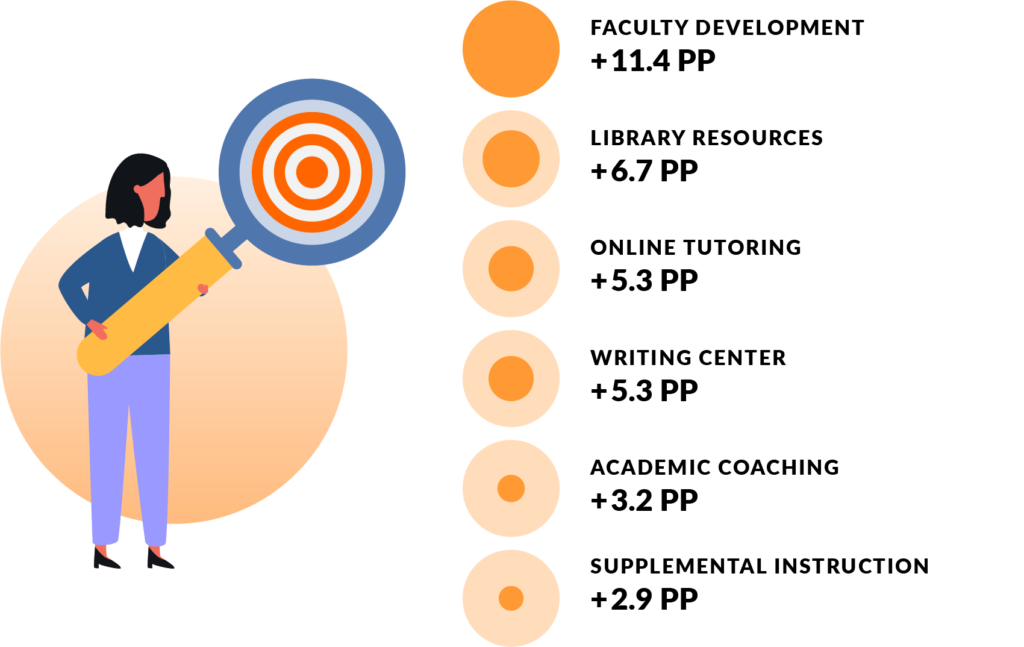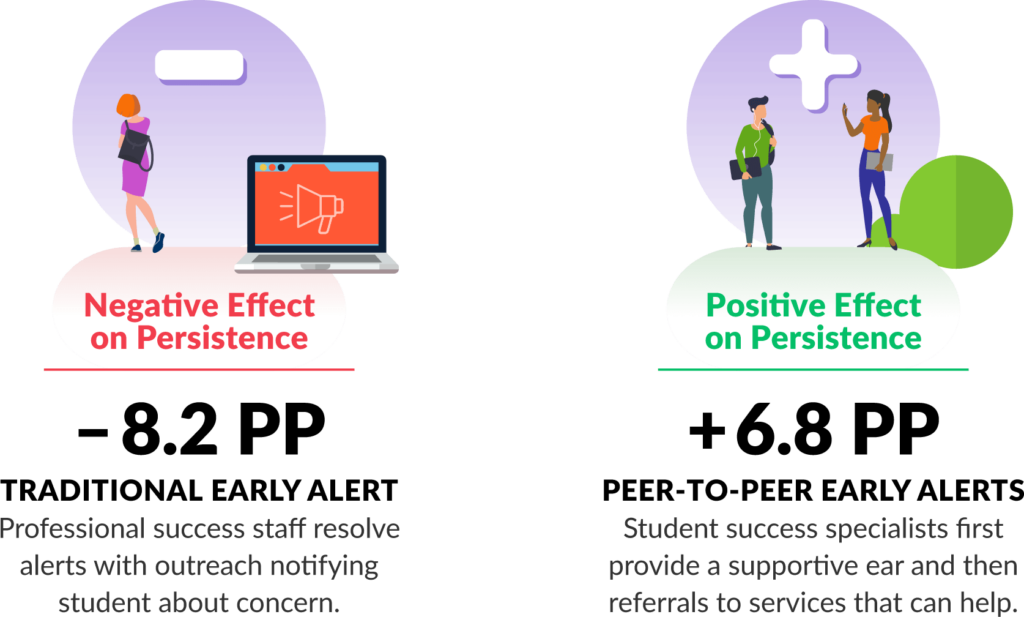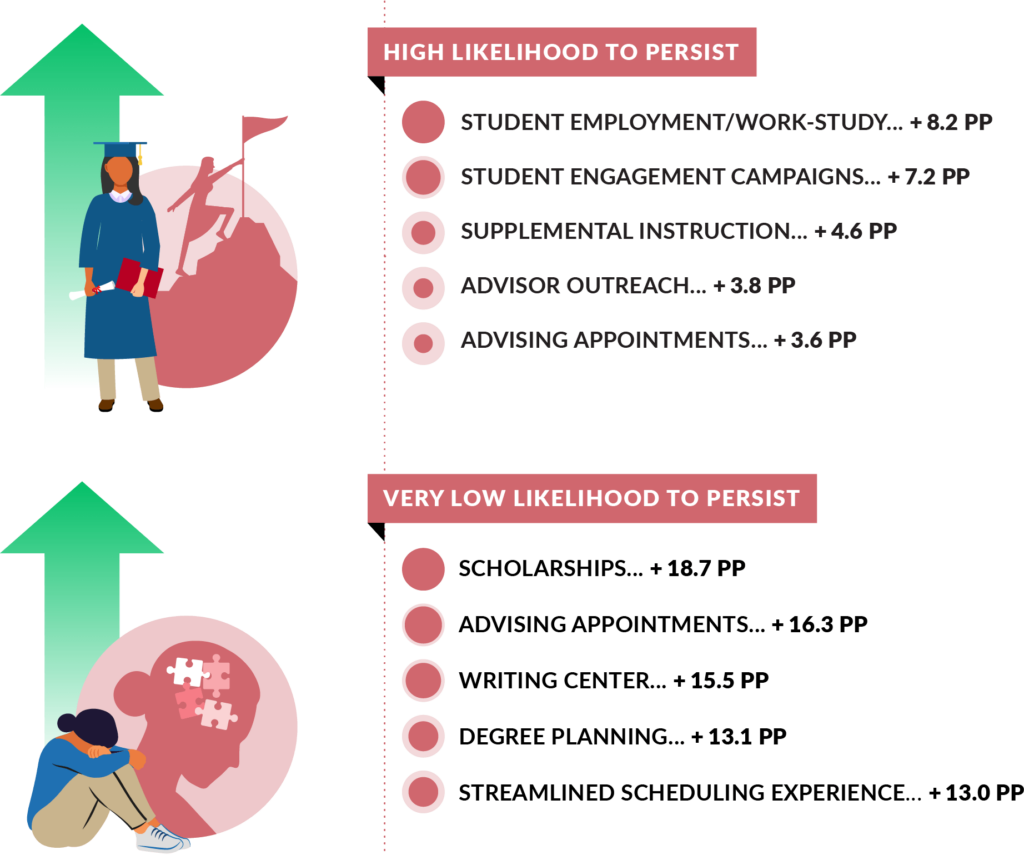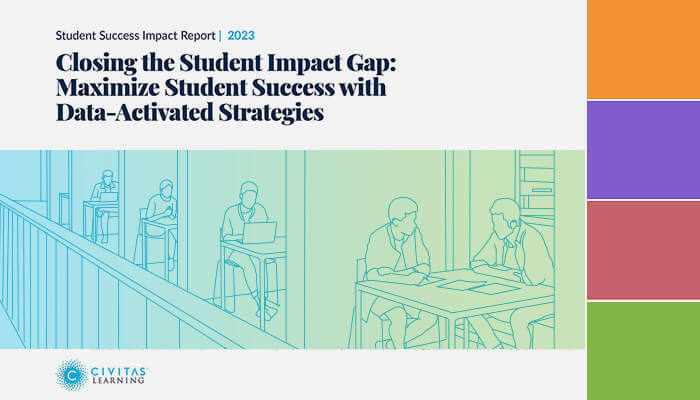Whether learning remotely, on-campus, or as a hybrid, students begin their higher education journey to build their future. But what makes some students persist to graduation and others not?
The answer lies in both tried-and-true initiatives, as well as investment in novel areas.
In Civitas Learning’s most recent Student Success Impact Report, we examined a broad range of student success initiatives across 48 institutions. We discovered the key steps leaders and institutions are taking to strategically –and sometimes dramatically– improve their retention rates.
5 High-Impact Retention Strategies
While institutions continue working hard to ensure their students graduate, initiative results often fall short of expectations. Declining enrollment, increasing competition, and shifting student priorities only add to the challenge of improving student success.
By carefully studying successful approaches within the Civitas Learning partner community, several high-impact retention strategies stood out as clear pathways forward:
- Student-centric degree planning
- Encouraging student engagement
- Investing in faculty development
- Appropriate use of properly tailored early alerts
- Pinpointing efforts to individual subsets of the student population
1. Student-Centric Degree Planning

significantly encourage persistence toward graduation.
Academic advising is a bedrock of any student’s successful persistence toward graduation. However, the old tried-and-true approach of assigning advisors the task of preparing degree plans for students is proving less and less effective.
In fact, analysis of partner institutions’ degree planning initiatives shows that advisor-assigned degree plans often harm student success.
The numbers are clear: when institutions flip the script and empower students to take the lead in their degree planning –with advisors available as a supportive guide– there’s a significant increase in student success, to the tune of a 6.9 PP positive impact.
Further, our findings demonstrate that today’s students benefit from support in fitting their education into their lives. Helping students plan and schedule their courses around work, caregiving, and other commitments encourages persistence toward graduation, with an easy and student-centric course scheduling experience having a 6.3 PP outcome.
2. Encouraging Student Engagement

Today, student success is about more than just making grades. There’s a growing trend among institutions to encourage students’ connections to their peers and school and foster a sense of belonging.
Data from the Civitas Learning community show colleges and universities increasingly promoting experiences that build engagement and interaction with the institution.
These student experiences aren’t fluff. They’re critical to retention and student persistence.
A long-time Civitas Learning partner actively sought ways to encourage student involvement. Their efforts more than doubled their four-year graduation rate and earned them national praise for their work.
To achieve these successes, leaders first evaluated activities that encourage student involvement to determine whether they impacted persistence—and, if so, for whom. Then they turned to the Civitas Learning Student Impact Platform to learn exactly how participation improved each student’s persistence probability.
Get Data-Informed Strategies to Your Inbox
3. Investing in Faculty Development

development yielded a significant increase in persistence.
The data demonstrates that investing beyond students has a significant impact on retention. One of the clearest data points surfaced in our analysis of success initiatives across the Civitas Learning community is that stronger faculty are imperative for student success.
Investing in faculty development, like continuing instructional education and certification programs, yielded a significant increase in persistence of 11.4 PP–a percentage point lift far greater than many tried-and-true initiatives.
4. Using Properly Tailored Early Alerts

While our trends analysis highlights retention strategies to implement, the data also reveals common student success practices that should be used with caution.
For instance, early alerts are an intervention that can be successful but quickly backfire if applied in a cookie-cutter way, resulting in a decrease in student success of 8.2 PP when misapplied.
However, one university avoided this pitfall and achieved truly exceptional results from its early alert program. The secret to its success? Building relationships.
The university has taken a peer-to-peer approach that focuses not on information but on engagement. This means employing students as success specialists to provide outreach, moving beyond a simple alert system to a facilitator of real human connection. The student success specialists provide a supportive ear and, when necessary, offer referrals to services that can help.
Our analysis for this report shows a 6.8 percentage-point lift in persistence.
The detailed results of this program are truly inspiring. In spring 2022, the peer-to-peer outreach campaign’s results included:
- 2,742 early alerts submitted to peer mentors
- 27% participation from faculty, up from 13% the prior year
- Approximately 20,000 messages sent and received
- 60-65% student response rate
5. Pinpointing Efforts to Your Unique Student Population

One-size-fits-all approaches simply don’t have a positive impact on retention. A tailored approach is critical to student success efforts, but leadership teams need access to segmented data about a wide range of activities to make this happen.
Analyzing student data for different populations empowers teams to move away from outdated, cookie-cutter practices and toward strategies customized for the student in front of them. Most critically, this customization gives institutions the right tools to connect programs and services to the students they will benefit most.
The result? Maximum ROI by ensuring the right combination of interventions reaches the right students and the ability to be responsive to students’ changing needs.
This year’s Student Success Impact Report shows the most high-performing initiatives by each population, and the numbers are often staggering.
For instance, students in the bottom quartile of persistence likelihood benefit from a 16.3 PP lift with advising appointments, a 13.1 PP lift with student-centric degree planning, and a 13.0 PP lift with easy course scheduling. And we see the power of peer-to-peer alerts demonstrated by up to a 19.4 PP increase for students of color.
Implement the Right Combination of Strategies to Improve Student Outcomes
We’re proud to have analyzed over 500 initiatives across 3.9 million students in our 28-page Student Success Impact Report. The findings illuminate how harnessing the power of numbers and the right combination of strategies improves student persistence and institutional retention.
The results are clear: the effective use of student success analytics—revealing who’s in need and how best to support them—creates true transformation by supporting students as individuals. Developing focused student retention strategies are key for sustained success, now and in the future.





